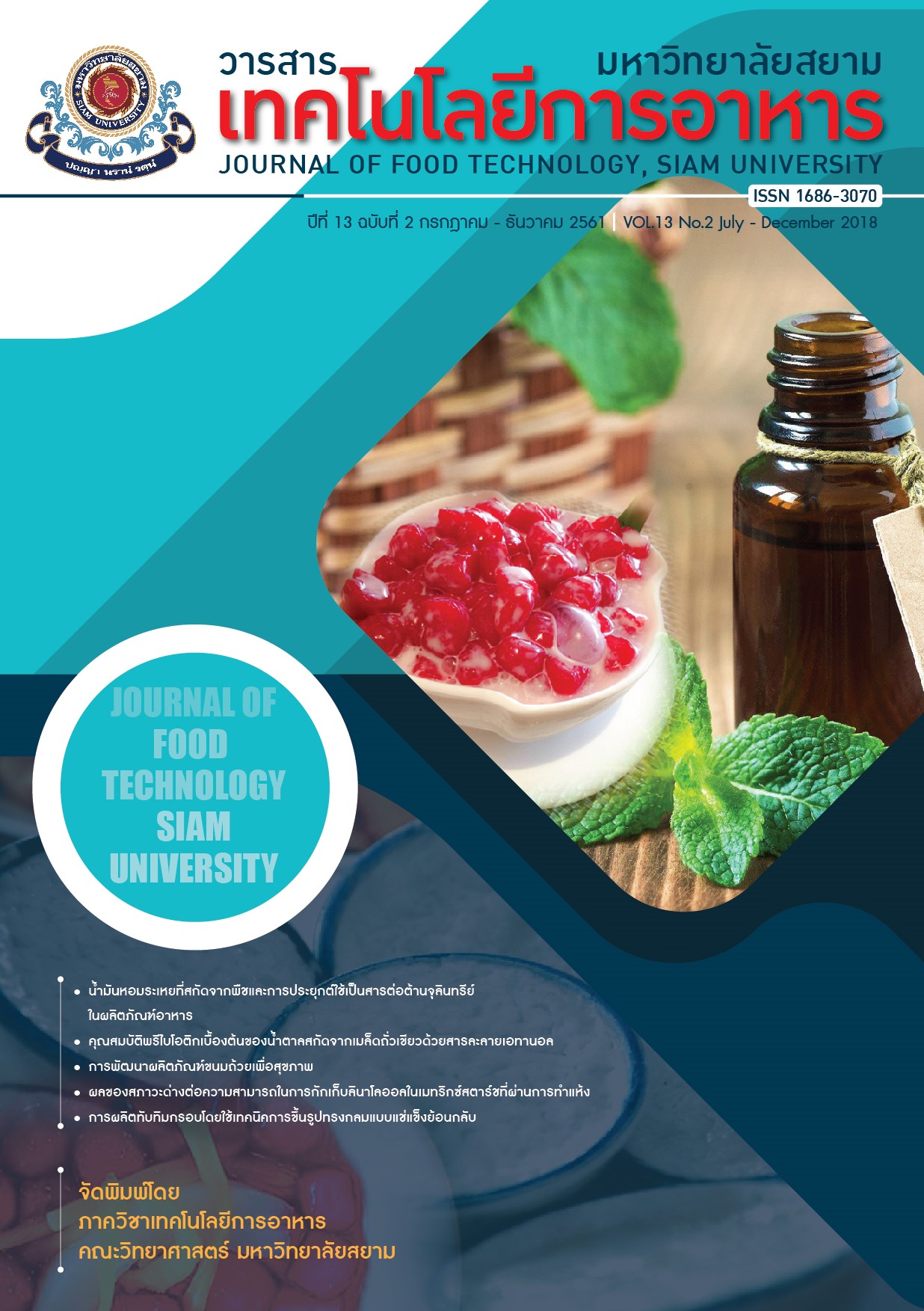Mock Pomegranate Seeds Dessert (Tab Tim Grob) Production using Frozen Reverse Spherification Technique
Main Article Content
Abstract
The objective of this research was to develop a Tab Tim Grob-balls product using frozen reverse spherification technique. The optimum concentrations of sodium alginate and calcium lactate were determined using response surface methodology (RSM) with central composite design (CCD). Subsequently, each products were evaluated to physical properties for weight, size, L-value, a-value, b-value and thickness of film. Thereafter, the Tab Tim Grob-balls from optimum conditions were further studied for sensory evaluation. The results showed that the difference in concentration of sodium alginate and calcium lactate had effected to physical properties of Tab Tim Grob-ball (p<0.05). In this study, thickness of film is the most predicted responses by showing 0.86 of coefficient of determination, (R2) and 0.03 mm. in thickness of film. According the prediction, the optimal conditions of Tab Tim Grob-balls were 1.05% sodium alginate and 0.77% calcium lactate. In which, the thickness of film was equal to the predicted responses. No marked differences in sensorial evaluation of Tab Tim Grob-balls product. In which, this product was accepted in range of like moderately level in color, braking ability of Tab Tim Grob-balls, shape and overall likeness of product.
Article Details
Copyrights of all articles in the Journal of Food Technology available in print or online are owned by Siam University and protected by law.
References
[2] P. Nithitantiwat and W. Udomsapaya. (2017). Food consumption behavior among Thai adolescents, impacts, and solutions. Journal of Phrapokklao Nursing College. 28(1): 122-128.
[3] Navarro, V., Serrano, G., Lasa, D., Aduriz, A.L. and Ayo, J. (2012). Cooking and nutritional science: Gastronomy goes further. International journal of gastronomy and food science. 1(1): 37-45
[4] Barrett, R. (2012). Molecular Gastronomy, Olin college of engineering. [Online] Available from https://rosebarrett.yolasite.com/ resources/Molecular %20Gastronomy%20 Case%20Study.pdf. [Accessed April 9, 2018].
[5] Lee, P. and Rogers, M.A. (2012). Effect of calcium source and exposure-time on basic caviar spherification using sodium alginate. International Journal of Gastronomy and Food Science. 1: 96-100.
[6] W. Pumpho. (2015). Tofu production using spherification technique. M.S. thesis, Agro-Industry., King mongkut’s institute of technology ladkrabang, Thailand.
[7] Nussinovitch, A. (1997). Hydrocolloid Application; Gum technology in the food and other industries. Blackie academic & professional, United Kingdom.
[8] Y. Likidsomboon and P. Pinsirodom. (2016). Preparation of “rice pearls” from Riceberry rice using spherification technique, In proceeding of 14th Naresuan agricultural conference, pp. 254-259, Naresuan University, Thailand.
[9] W. Pumpho and A. Dholvitayakhun. (2018). Effect of concentration and time to produce black jelly ball, In proceeding of 2th National Graduate Research Conference, pp. 935-939. Chiang Mai: Maejo University, Thailand.
[10] M. Horrattanachai and A. Chulerk. (1995). Traditional Thai desserts, Mae Ban publisher.
[11] Derringer, G. and Suich, R. (1980). Simultaneous optimization of several response variables. Journal of Quality Technology. 12(4): 214-219.
[12] Meilgaard, M., Civille, C.V. and Carr, B.T. (1990). Sensory Evaluation Techniques. CRC Press, Inc., Florida, USA.
[13] Sen, D.J. (2017). Cross linking of calcium ion in alginate produce spherification in molecular gastronomy by pseudoplastic flow. World Journal of Pharmaceutical Sciences. 5(1): 1-10.
[14] Harrington, E.C. (1965). The desirability function. Industrial Quality Control. 21(10): 494-498.
[15] Lupo, B., Maestro, A., Gutiérrez, J. M., and González, C. (2015). Characterization of alginate beads with encapsulated cocoa extract to prepare functional food: Comparison of two gelation mechanisms. Food Hydrocolloids. 49: 25-34.
[16] Tsai, F.-H., Kitamura, Y. and Kokawa, M. (2017). Liquid-core alginate hydrogel beads loaded with functional compounds of radish by-products by reverse spherification: Optimization by response surface methodology. International Journal of Biological Macromolecules. 96: 600-610.


